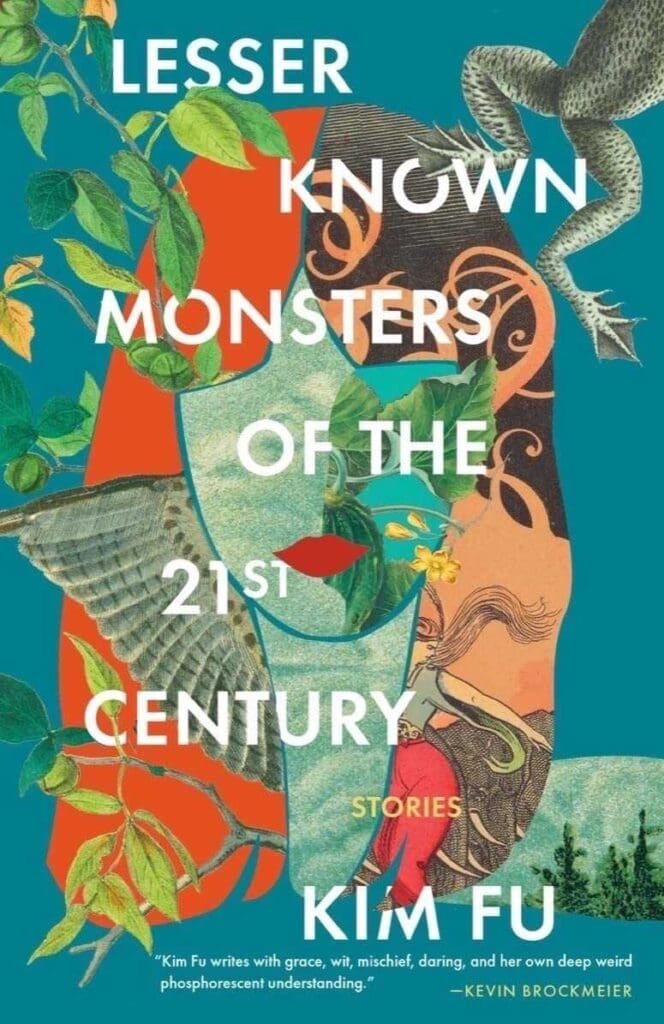As the planet careens into 2022, surrealism might be the best way to capture our psyche. Kim Fu’s first story collection, Lesser Known Monsters of the 21st Century (220 pages; Tin House Books), makes a convincing argument for such an idea. Without referencing any specific events or cultural moments, the twelve pieces in Fu’s aptly titled fourth book capture a wide swath of modern maladies. In a recent interview with The Rumpus, Fu stated she wanted in her work to take “speculative ideas very seriously and at face value…without a winking eye to metaphor.” Remarkably, she succeeds, avoiding the pitfalls of artfully occluded moralizing while saturating her stories with much-discussed contemporary woes ranging from insomnia to paralyzingly cynical social mores.
The opening story, “Pre-Simulation Consultation XF007867,” tugs the reader into a bleakly imaginary but believable world, setting the tone for the whole volume. Written entirely in dialogue, “Pre-Simulation” etches a conversation between someone turning to technology to assuage their grief and the employee who must decide whether to help. It skewers no particular tech giant or online service, but opens up real questions about corporate ethics and companies’ responsibility for the addictive nature of their technologies.
“Liddy, First to Fly,” is an elegant meditation on girlhood and its ephemeral possibilities, while “Time Cubes” offers an eerie glimpse into the life of a depressed person living in a dystopian mall; later in the collection comes “20 Hours,” a deceptively quiet piece from the mind of a man who commits uxoricide without any consequences.
With the slyly comic “In This Fantasy,” Fu taps into the yearning minds of everyone trapped in the arid mundanity that is a comfortable life in a capitalist society. Our narrator confesses to fantasies that are not daydreams of beauty and freedom but romantically textured experiences of melancholic drama. This is ticklishly relatable, as in one moment when the narrator imagines a confrontation in the wilderness with a wolf and muses:
In this fantasy, I am the kind of person who straightens her spine to grow larger, who knows not to run, who meets power with power. (Who doesn’t begin an email about a six-months-overdue invoice with “Sorry to bother you.”)
“In This Fantasy” is one of several stories gesturing at Fu being a poet as well as the author of the novel For Today I Am a Boy, a finalist for the PEN/Hemingway Award. At times the stories of Lesser Known Monsters seem more akin to poetry. Tautly controlled language, often to the point of spareness, communicates the lyrical imagination that is the foundation for each piece. Fu tends toward diligently precise descriptions, such as in “Liddy, First to Fly”: Raised white bumps protruded from Liddy’s skin, one on the outside of each ankle, each a few inches above the rounded knob of bone—perfectly symmetrical. Such language can make the whimsical viscerally real, but in other instances it feels at odds with the dark dream of the story. Regardless, this linguistic tension encapsulates what Fu is playing with: merging the surreal and the concrete, the impossible and the way-too-real.
Fu’s mastery of clever, strange concepts is undeniable throughout, but it is in the final two stories that her work achieves transcendence. “Bridezilla” follows a thirtysomething woman wrestling with her desire to have a wedding despite her friend group’s cynicism. The story is playful, poking at the pomposity of a certain type of social circle, and culminates in a gorgeously bizarre ending. The closing story, “Do You Remember Candy,” delivers a tight exploration of a mother-daughter relationship and the urge to create, set against the aftermath of a worldwide sensory cataclysm. Laced with incredible detail and poignant imagery, the story resonates deeply.
It is unclear whether the lesser known monsters Kim Fu addresses are our 21st century selves, or our modern neuroses. The beauty of her collection is that we can never really know—or perhaps there is no separating the two.

